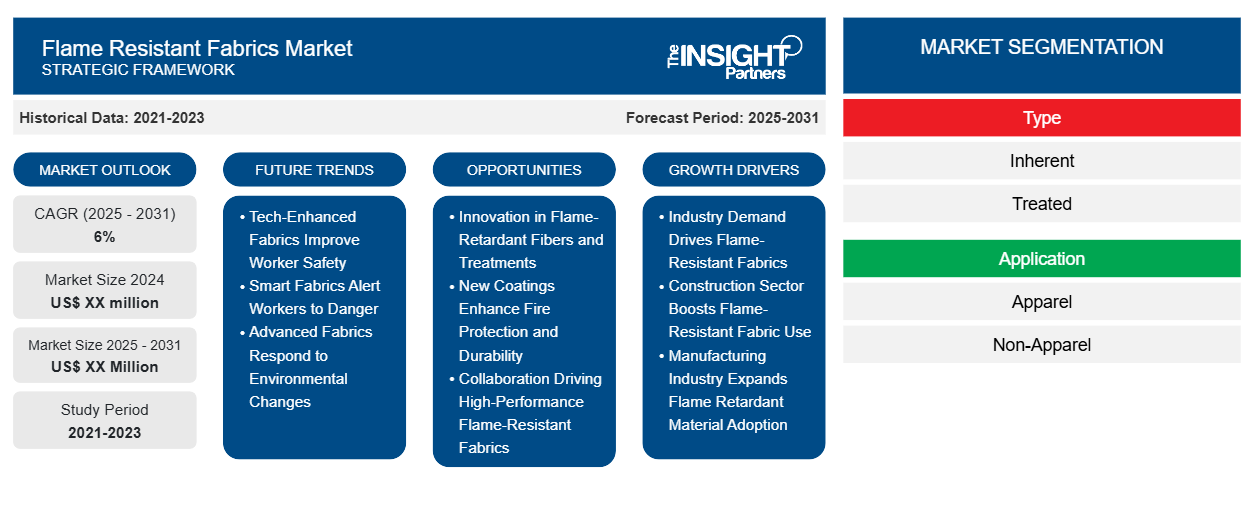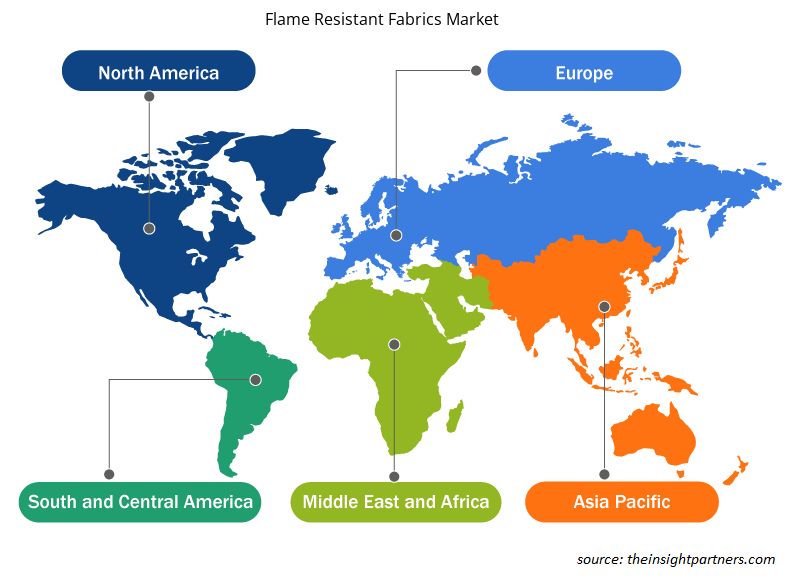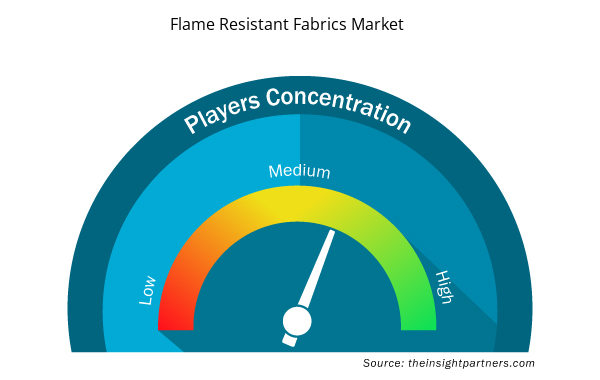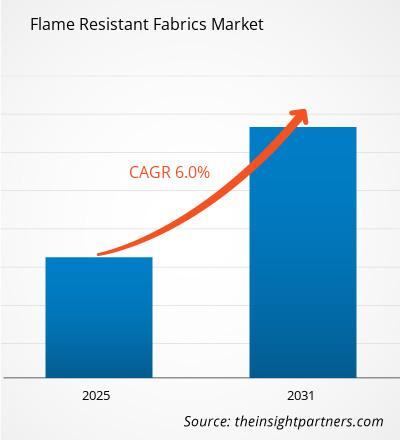The Flame Resistant Fabrics Market is expected to register a CAGR of 6% from 2025 to 2031, with a market size expanding from US$ XX million in 2024 to US$ XX Million by 2031.
The flame resistant fabrics market report presents analysis based on type (inherent and treated). The report is segmented by application (apparel and non-apparel). The report is segmented by end-use industry (automotive, aerospace, marine, oil and gas, chemical, building and construction, industrial, and others). The global analysis is further broken-down at regional level and major countries. The market size and forecast at global, regional, and country levels for all the key market segments are covered under the scope. The report offers the value in USD for the above analysis and segments. The report provides key statistics on the market status of the key market players and offers market trends and opportunities.
Purpose of the Report
The report Flame Resistant Fabrics Market by The Insight Partners aims to describe the present landscape and future growth, top driving factors, challenges, and opportunities. This will provide insights to various business stakeholders, such as:
- Technology Providers/Manufacturers: To understand the evolving market dynamics and know the potential growth opportunities, enabling them to make informed strategic decisions.
- Investors: To conduct a comprehensive trend analysis regarding the market growth rate, market financial projections, and opportunities that exist across the value chain.
- Regulatory bodies: To regulate policies and police activities in the market with the aim of minimizing abuse, preserving investor trust and confidence, and upholding the integrity and stability of the market.
Flame Resistant Fabrics Market Segmentation
Type
- Inherent
- Treated
Application
- Apparel
- Non-Apparel
End-Use Industry
- Automotive
- Aerospace
- Marine
- Oil and Gas
- Chemical
- Building and Construction
- Industrial
Geography
- North America
- Europe
- Asia-Pacific
- South and Central America
- Middle East and Africa
Customize This Report To Suit Your Requirement
You will get customization on any report - free of charge - including parts of this report, or country-level analysis, Excel Data pack, as well as avail great offers and discounts for start-ups & universities
Flame Resistant Fabrics Market: Strategic Insights

- Get Top Key Market Trends of this report.This FREE sample will include data analysis, ranging from market trends to estimates and forecasts.
Flame Resistant Fabrics Market Growth Drivers
- Industry Demand Drives Flame-Resistant Fabrics: Rising needs of oil and gas, construction, and manufacturing industries, in particular, fuel the expansion of the flame resistant fabrics market. For example, workers in oil and gas facilities work under extreme environmental conditions and thus need flame-resistant clothing. This increased emphasis on safety translates to an increase in the consumption of such fabrics.
- Construction Sector Boosts Flame-Resistant Fabric Use: Likewise, the construction industry is also experiencing a rise in regulatory measures, thereby making it mandatory for all workers to wear fire-proof attires. As the nature of construction works poses higher risks and larger scale projects are implemented, construction companies are more inclined to use fire-resistant uniforms in order to reduce the risk posed by fire. Such a scenario not only assures safety for the workers but also aids in the expansion of flame resistant fabric providers.
- Manufacturing Industry Expands Flame Retardant Material Adoption: In the manufacturing industry, the use of flame retardant materials is generally a requirement for ensuring employees’ safety within the working area where the risks of fire and explosions exist. Such sewing firms as those in the aerospace, automotive and metalworking sectors have safety systems that demand the use of flame resistant materials. Such widespread use in different sectors is a factor that aids in enhanced growth of the market.
Flame Resistant Fabrics Market Future Trends
- Tech-Enhanced Fabrics Improve Worker Safety: The rise of technologically enhanced flame-resistance fabrics is one more factor that is becoming popular in the market of protective wear. Such suitable clothing for such professionals has also been advanced to include embedded sensors and the Internet of Things. This allows temperature and hazardous exposure levels to be monitored in real time, enhancing the safety of individuals working in hazardous places.
- Smart Fabrics Alert Workers to Danger: Smart flame-resistant fabrics can alert users when they might be in danger, allowing faster response times during emergencies. For instance, temperature sensors can warn workers when approaching extreme heat warnings, enabling a fast reaction. This mentality towards safety is proving very attractive in markets such as oil and gas and construction.
- Advanced Fabrics Respond to Environmental Changes: In addition, the producers are looking into developing advanced functionalities of materials that can change as per the environment. These advanced fabrics would improve the level of protection by their ability to change characteristics in response to temperature changes. These kinds of innovations have put the manufacturers in a better place to cater to the changing demands of safety-imperative industries, thus allowing more growth in the market.
Flame Resistant Fabrics Market Opportunities
- Innovation in Flame-Retardant Fibers and Treatments: The flame-retardant textiles sector is expected to gain the growth prospects in the innovation of new flame-retardant fibers and surface treatments. For instance, advanced chemical formulations such as improved aramid fiber composites and biopolymers help enhance the flame resistance in clothing without compromising on comfort and freedom of movement.
- New Coatings Enhance Fire Protection and Durability: New strategies, including chemical coatings and unique fabric portfolios, enhance the options available for classical fabrics. The developments not only improve the level of fire protection but also the wear and the weathering resistance. The companies pursuing randd activities can position their offerings favorably in the context of the market competition and provide their products to industries concerned about safety.
- Collaboration Driving High-Performance Flame-Resistant Fabrics: Furthermore, joint efforts of textile producers and inventors are already yielding exceptional products. Media such as these allow the utilization of both to speed up the processes of innovations. Thus, new flame-resistant fabrics with very high-performance properties are being manufactured, and these fabrics are in demand in many fields, including aviation, automotive, and construction.
Flame Resistant Fabrics Market Regional Insights
The regional trends and factors influencing the Flame Resistant Fabrics Market throughout the forecast period have been thoroughly explained by the analysts at Insight Partners. This section also discusses Flame Resistant Fabrics Market segments and geography across North America, Europe, Asia Pacific, Middle East and Africa, and South and Central America.

- Get the Regional Specific Data for Flame Resistant Fabrics Market
Flame Resistant Fabrics Market Report Scope
| Report Attribute | Details |
|---|---|
| Market size in 2024 | US$ XX million |
| Market Size by 2031 | US$ XX Million |
| Global CAGR (2025 - 2031) | 6% |
| Historical Data | 2021-2023 |
| Forecast period | 2025-2031 |
| Segments Covered |
By Type
|
| Regions and Countries Covered | North America
|
| Market leaders and key company profiles |
Flame Resistant Fabrics Market Players Density: Understanding Its Impact on Business Dynamics
The Flame Resistant Fabrics Market market is growing rapidly, driven by increasing end-user demand due to factors such as evolving consumer preferences, technological advancements, and greater awareness of the product's benefits. As demand rises, businesses are expanding their offerings, innovating to meet consumer needs, and capitalizing on emerging trends, which further fuels market growth.
Market players density refers to the distribution of firms or companies operating within a particular market or industry. It indicates how many competitors (market players) are present in a given market space relative to its size or total market value.
Major Companies operating in the Flame Resistant Fabrics Market are:
- Glen Raven, Inc.
- Milliken and Company
- Marina Textil.
- Texfire
- DALETEC
Disclaimer: The companies listed above are not ranked in any particular order.

- Get the Flame Resistant Fabrics Market top key players overview
Key Selling Points
- Comprehensive Coverage: The report comprehensively covers the analysis of products, services, types, and end users of the Flame Resistant Fabrics Market, providing a holistic landscape.
- Expert Analysis: The report is compiled based on the in-depth understanding of industry experts and analysts.
- Up-to-date Information: The report assures business relevance due to its coverage of recent information and data trends.
- Customization Options: This report can be customized to cater to specific client requirements and suit the business strategies aptly.
The research report on the Flame Resistant Fabrics Market can, therefore, help spearhead the trail of decoding and understanding the industry scenario and growth prospects. Although there can be a few valid concerns, the overall benefits of this report tend to outweigh the disadvantages.
- Historical Analysis (2 Years), Base Year, Forecast (7 Years) with CAGR
- PEST and SWOT Analysis
- Market Size Value / Volume - Global, Regional, Country
- Industry and Competitive Landscape
- Excel Dataset


- Industrial Valves Market
- Greens Powder Market
- Single-Use Negative Pressure Wound Therapy Devices Market
- Pressure Vessel Composite Materials Market
- Sodium Bicarbonate Market
- Clinical Trial Supplies Market
- Nuclear Waste Management System Market
- Compounding Pharmacies Market
- Legal Case Management Software Market
- Digital Language Learning Market

Report Coverage
Revenue forecast, Company Analysis, Industry landscape, Growth factors, and Trends

Segment Covered
This text is related
to segments covered.

Regional Scope
North America, Europe, Asia Pacific, Middle East & Africa, South & Central America

Country Scope
This text is related
to country scope.
Frequently Asked Questions
Based on geography, Asia Pacific held the largest share of the flame resistant fabrics market due to rapid industrialization and urbanization in countries like China and India have significantly increased demand for fire-safe materials in construction and infrastructure projects.
The increasing demand from the oil and gas, construction, and manufacturing sectors is driving the market growth.
The integration of smart technologies into flame-resistant fabrics is expected to be the key market trends.
Glen Raven, Inc.; Milliken and Company; Marina Textil.; Texfire; DALETEC; LEVITEX; Francisco Jover S.A.; Manifattura Pri.Ma.Tex S.r.l.; TenCate Protective Fabrics; and Eastwell Industries Pvt. Ltd. are some of the key players operating in the flame resistant fabrics market
Based on type, the treated segment is expected to witness the fastest growth during the forecast period
The Flame Resistant Fabrics Market is estimated to witness a CAGR of 6% from 2023 to 2031
Trends and growth analysis reports related to Chemicals and Materials : READ MORE..
1.DuPont
2.Glen Raven, Inc.
3.Gun Ei Chemical Industry Co. Ltd.
4.Huntsman Corporation
5.Lenzing AG
6.Milliken and Company
7.PBI Performance Products
8.Royal Tencate Corporate EMEA
9.Solvay SA
10.Teijin Aramid

 Get Free Sample For
Get Free Sample For